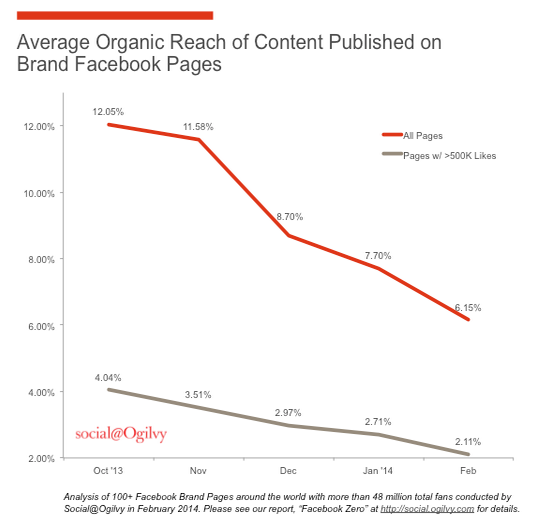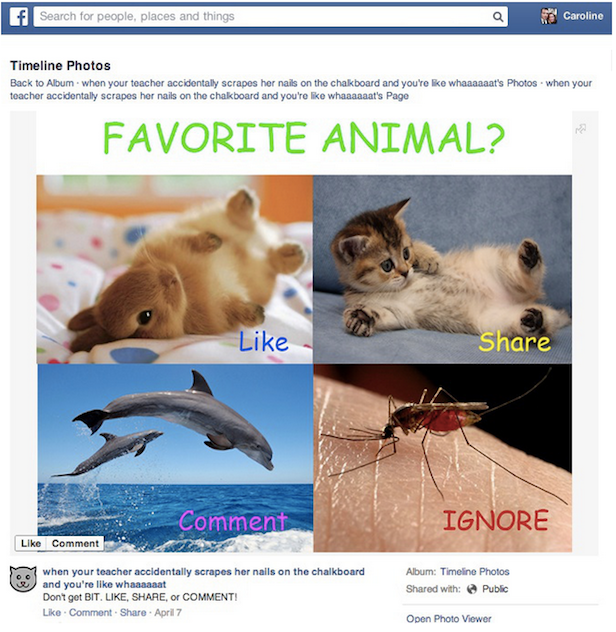Some of you that follow closely the traffic generated by your Facebook pages may have noticed a considerable decrease in your post views and interaction over the past few months. It was actually last year (2013) in December, that Facebook released a major algorithm change to its News Feed affecting primarily the organic reach for many Pages. In the graphic below from Ogilvy, you can actually see that even before the algorithm update, the organic impact from your posts was already on its way down with a reach as low as 6% for the average Page audience.
But it doesn’t end there. If you think that 6% is too low, according to Sam Biddle from ValleyWag, the percentage of people that will actually see your posts will go even lower.
“A source professionally familiar with Facebook’s marketing strategy, who requested to remain anonymous, tells Valleywag that the social network is “in the process of” slashing “organic page reach” down to 1 or 2 percent. That would mean an advertising giant like Nike, which has spent a great deal of internet effort collecting over 16 million Facebook likes, would only be able to affect around 160,000 of them when it pushes out a post. Companies like Gawker, too, rely on gratis Facebook propagation for a huge amount of their audience.”
Biddle also notes how the fewer “Likes” a page has, the fewer your number will actually be. Talk about depending on Facebook for your marketing success!
“That 160,000 still sounds like a lot of people, sure,” he writes. “But how about my favorite restaurant here in New York, Pies ‘n’ Thighs, which has only 3,281 likes—most likely locals who actually care about updates from a nearby restaurant? They would reach only a few dozen customers. A smaller business might only reach one. This also assumes the people ‘reached’ bother to even look at the post.”
Facebook’s explanation sounded almost arrogant, but to the point:
“We expect organic distribution of an individual page’s posts to gradually decline over time as we continually work to make sure people have a meaningful experience on the site.”
So you work so hard to create campaigns, create interesting posts, earn new “Likes” for your page, and Facebook rewards you by showing your posts to just about 1% – 2% of your audience? You would think that if your page has 3,000 likes – these are people that have clicked the “LIKE” button to follow you- the majority of them should be able to see your posts in their News Feed. The reality? You’ll be lucky if you get 30-50 post views. Take that as a reward for Social Media efforts!
On the other hand, Facebook is also determining for its users, what stories to add to their News Feeds even if they are from pages that they haven’t even liked.
In a separate announcement released on April 10, Facebook released even more changes to its News Feed algorithm, this time aimed at “cleaning up News Feed spam”. It looks like Facebook will be now be targeting three specific types of posts, and stop showing them in the News Feed: these are like-baiting, frequently circulated content, and spammy links.
According to Facebook’s announcement:
“The goal of News Feed is to deliver the right content to the right people at the right time so they don’t miss the stories that are important and relevant to them. Today we are announcing a series of improvements to News Feed to reduce stories that people frequently tell us are spammy and that they don’t want to see. Many of these stories are published by Pages that deliberately try and game News Feed to get more distribution than they normally would. Our update targets three broad categories of this type of feed spam behavior.”
Hopefully, Facebook will be able to determine what is a “spammy” post quite accurately, otherwise, your legitimate posts may be seen by even fewer people. Ever seen a legitimate email from a trusted source end up in your Junk folder? Well, the same could happen if Facebook determines for you that your post is spam and not legitimate. It will simply not show it to your page followers.
To address this concern, Facebook adds:
“The vast majority of publishers on Facebook are not posting feed spam so should not be negatively impacted by these changes, and, if anything, may see a very small increase in News Feed distribution,”
I bolded the sections that could fall into interpretation and will cause some concern.
So what does Facebook consider to be “spammy” content or links? In their words, Facebook considers spammy links those that use “inaccurate language or formatting to try and trick people into clicking through to a website that contains only ads or a combination of frequently circulated content and ads.”
“For instance, often these stories claim to link to a photo album but instead take the viewer to a website with just ads,” Facebook also explains that it can better detect these types of links by measuring how frequently people choose to like the original post or share it with their friends. If you’re fond of publishing these types of links, you will see your reach decrease over the next few months, Facebook says.
My conclusion? I think those of you that follow this blog already know my position about how to approach marketing these days. Always market your BRAND and use a Multichannel Marketing approach that is diversified. Your brand, you can control. Facebook, Google, YouTube and all other major players, you can’t. Use them to your advantage but stay true to your brand and your customers will ultimately find you, regardless of what Facebook, Google, YouTube or any other channel decides to do to their algorithms.
Until next time, this is Manuel Gil del Real (MGR)






